The guide for making the best pie crust recipe: an easy and flaky butter shortening double pie crust made in 10 minutes, with an added secret ingredient.
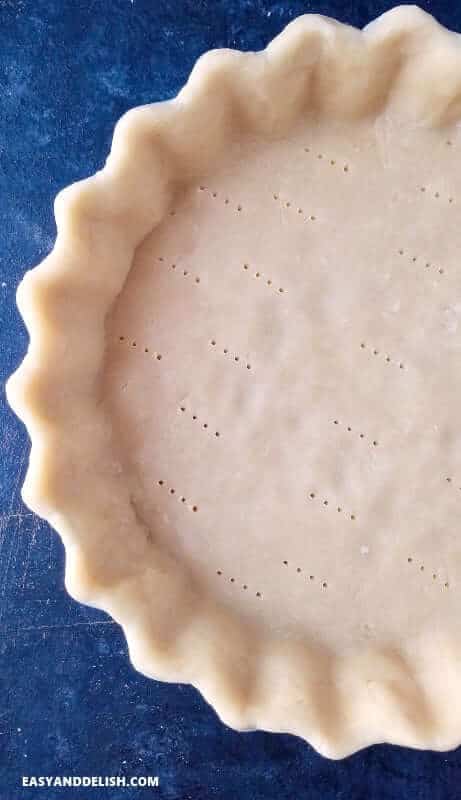
Table of Contents
- 1 HOW TO MAKE A FLAKY PIE CRUST FROM SCRATCH
- 2 WHAT MAKES THE BEST PIE CRUST?
- 3 ALL-BUTTER VS. SHORTENING VS. BUTTER SHORTENING PIE
- 4 TIPS FOR ROLLING OUT PIE CRUST
- 5 CAN PIE CRUST BE FROZEN?
- 6 WHY PIE CRUST SHRINKS?
- 7 WHAT CAN I DO WITH CRUMBLY PIE CRUST?
- 8 HOW DO I PREVENT SOGGY PIE CRUST?
- 9 WHY DO YOU PUT VINEGAR IN PIE CRUST?
- 10 WHERE DO I FIND PIE CRUST IN THE GROCERY STORE?
- 11 PIE RECIPES TO TRY
- 12 Secrets for the Best Pie Crust Recipe
When it comes to pie crust, I compare them to colors: every person has their own favorite. The disagreements are mostly when it comes to texture, whether the perfect crust is tender or flaky... and less often about flavor, whether the best is buttery or more neutral.
If you root for Team Flaky, discover here the secrets for a flaky yet flavorful homemade pie crust. Don't you worry! Our pie crust recipe is as easy as... pie! And homemade tastes better than any store-bought pie dough.
There is an added plus to this recipe. You don't need to knead this double pie crust recipe by hand! YAY!
We will be also answering some the most common questions about the perfect pie crust.
HOW TO MAKE A FLAKY PIE CRUST FROM SCRATCH
Here is how to make an easy pie crust recipe at home.
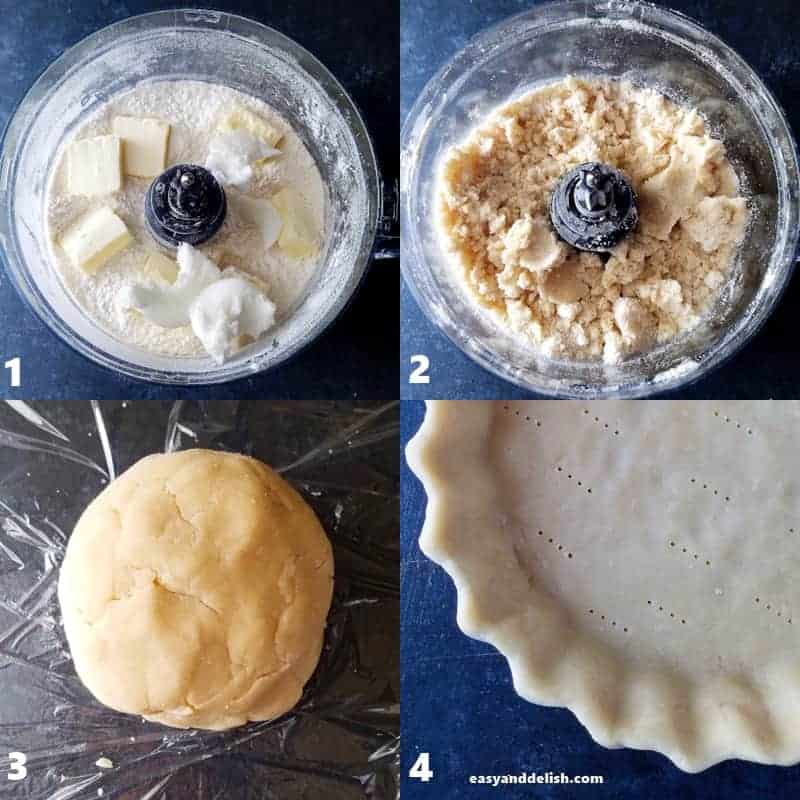
- In the bowl of a food processor fitted with a steel blade, pulse flour, sugar, and salt a few times until combined. Add the butter and shortening, pulsing about 8 times or until the butter is the size of peas. (SEE PICS. 1 and 2)
- With the processor running, pour the ice water (and vodka) down the feed tube and pulse until the dough begins to form a ball.
- Dump dough out onto a floured board and roll into a ball. Wrap in plastic wrap and place in the fridge for 30 minutes. (SEE PIC. 3)
- Cut the dough in half. Flour both a flat surface and rolling pin, and roll it out to uniform thickness of ⅛ inch (3 mm). Use even strokes and roll out from the center to the edges, forming a circle that is 1-inch larger than the pie pan.
- Then, lift the dough without breaking it by lightly rolling it around the rolling pin. But beforehand make sure dough it is not sticking to the surface.
- Allow the dough to drop into the pan. Make sure to press it into the corners (to avoid puffing up once baked), yet without stretching the dough. Stretched dough will shrink during baking.
- With a sharp paring knife, cut the dough 1 inch larger around than the pan. Then, either flute or crimp the edges. Prick both bottom and sides with a fork. (SEE PIC. 4)
- At this point, you can either fill/bake the homemade pie crust, refrigerate for about 3 days, or freeze for up to 6 months.
WHAT MAKES THE BEST PIE CRUST?
There are basically 2 main factors that determine the best pie crust:
1. PIE CRUST INGREDIENTS
- FLOUR -- pastry flour is the top choice when it comes to pie crust. Why? Because it is a low protein flour (about 8-10%) that has enough gluten to achieve a flaky crust, yet is low enough to produce tenderness. This means, a happy medium between flakiness and tenderness. The con is that is not a flour available at every supermarket such as a big retailers like Walmart. All-purpose flour would be the second suitable option. It can be found pretty much everywhere and can still produce a good result. However, for this choose one with the lowest protein percentage available, and increase the proportion of shortening slightly.
- FAT -- Lard produces the most flavorful pie crust, being firm and moldable enough to produce a workable dough. It would be the number one choice if it weren't more expensive and less available than butter and shortening. Like lard, butter makes for very tasty pie crusts, but with a tender texture since it contains moisture. Plus, it costs more than shortening. Hydrogenated shortening, in contrast, lacks flavor but produces a flakier dough on account of its plastic consistency.
- Because of the above factors, a combination of butter and shortening unites the 4 key elements for the best pie crust: flavor, flakiness, affordability, and availability.
- LIQUID(S) -- The most common liquids are water and milk. Water is free, providing structure and flakiness. If too much water is added, the crust will become tough because too much gluten is developed. In contrast, if not enough water is used, the crust will fall apart. Milk makes for a dough that is richer but which can brown more quickly and is less crisp. As for vodka: if you have in your pantry, use it! It makes the crust roll out easier than water, and the alcohol will evaporate in the baking process. You can use apple cider vinegar if desired. In any of these cases attention to temperature is essential: the liquid must be chilled (40° F/4° C) to maintain the proper dough temp.
- SALT -- it gives flavor while tenderizing the gluten. To assure an even distribution, either dissolve it in water or pulse/mix well with the dry ingredients.
- SUGAR --it balances out the salt and gives tenderness. Not every pie crust recipe contains sugar, however.
2. TEMPERATURE:
The best pie crusts are kept cold both during mixing and makeup. Why? First, the gluten develops slower at cool temps. Second, shortening has the best consistency when cool.
ALL-BUTTER VS. SHORTENING VS. BUTTER SHORTENING PIE
All-butter pie crust is the most flavorful, the most beautiful in color (bright yellow), and the most tender as well.
In contrast, the all-shortening crust, lacked flavor but was flakier, and had a brownish color.
The butter/shortening pie crust combined both flavor and a balanced combination of flakiness and tenderness. In terms of color, it is like butter and shortening had a baby. 🙂
The overall winner? For me and my family, it was the butter/shortening crust!
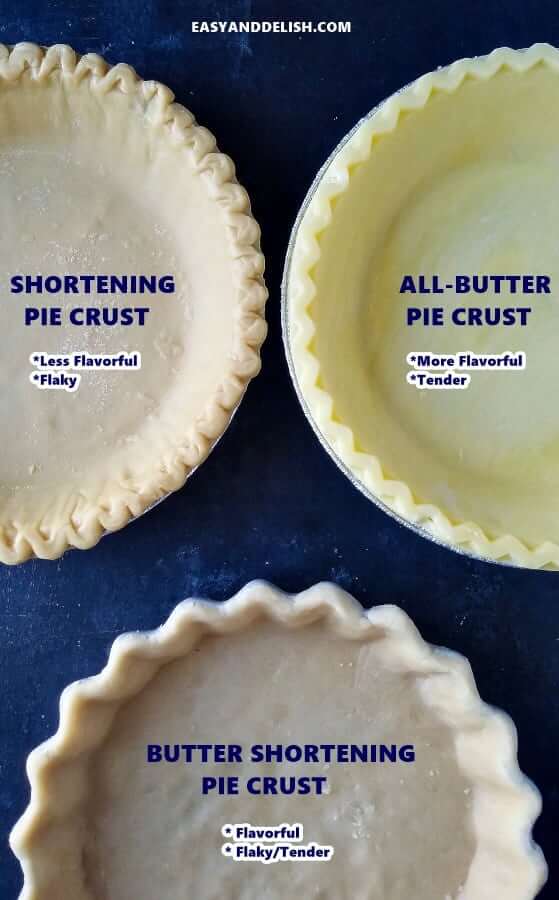
TIPS FOR ROLLING OUT PIE CRUST
- Once pie dough is made and has chilled down for about 30 minutes in order to relax the gluten strands, roll out and place into the pan. From there, you can fill/bake, refrigerate, or freeze.
- If completely chilled before rolling out, it will require some time to come up to a temp that allows for rolling it out. Save yourself time and trouble!
- To roll out dough, flour a flat surface (and rolling pin) and roll it out to an uniform of ⅛ inch (3 mm) thickness. Use even strokes and roll out from the center to the edges, forming a circle.
- Then, lift the dough without breaking it by rolling it lightly around the rolling pin. But beforehand make sure dough it is not sticking to the surface.
- Allow the dough to drop into the pan and make sure to press it into the corners (to avoid puffing once baked) but without stretching the dough. Stretched dough will shrink during baking.
CAN PIE CRUST BE FROZEN?
Yes! To freeze unbaked pie crust, wrap crust tightly with plastic freezer wrap and freeze for up to 6 months. You can bake straight out of the freezer (no need to thaw first), adding about 3-4 minutes to the baking time stated in the recipe.
WHY PIE CRUST SHRINKS?
There is more than one reason why pie crust shrinks.
1. One of them is that pie dough didn't rest enough once made, thus not allowing the gluten strands to relax enough.
2. The shrinking may also be a result of an over mixed dough. The more you mix, the tougher the dough becomes, causing shrinking.
3. Moreover, do not stretch the dough when placing into the pan, otherwise it will shrink when baking.
ARE PIE CRUST AND TART CRUST THE SAME?
They may or may not be the same, depending on which pastry dough you choose. A shortcrust pastry works the same for both pie crust and tart crust.
On the other hand, pâte sablée works better for sweet tarts and tea biscuits, and piped shapes than other short doughs. In contrast to a pie dough, no water is needed with pâte sablée and the dough is not temperature-sensitive.
WHAT CAN I DO WITH CRUMBLY PIE CRUST?
If the dough is crumbly and not rolling out without easily breaking, it is because the crust is too dry. Adding chilled water, one teaspoon at a time, will help the dough to roll out easier.
If the dough is cracking only at the edges, let the dough warm up just a little bit and then seal the crack gently, pressing with your fingers.
HOW DO I PREVENT SOGGY PIE CRUST?
To prevent sogginess, you can use any of these simple methods:
1. Pre-bake the pie crust before adding any wet fillings.
2. Before adding the filling, brush the bottom and sides of the unbaked crust with a beaten egg, or with egg white mixed with water. This creates a protective barrier between the crust and the filling.
WHY DO YOU PUT VINEGAR IN PIE CRUST?
Adding apple cider vinegar (as well as vodka) helps to make a tender pie crust...
WHERE DO I FIND PIE CRUST IN THE GROCERY STORE?
Store-bought pie crust is usually available in the freezer aisle. There are all-butter crusts, shortening crusts, butter/shortening crusts, gluten-free, and even vegan pie crusts.
PIE RECIPES TO TRY
- Ruby Apple Pie
- Sweet Potato Pie
- Dulce de Leche Apple Hand Pies
- Peach Maple Breakfast Pie
Secrets for the Best Pie Crust Recipe
Equipment
- mixer
- pie pan
Ingredients
- 3 cups all-purpose flour
- 1 tablespoon granulated sugar
- 1 teaspoon salt
- 12 tablespoon unsalted butter chilled and cut into chunks
- 6 tablespoon vegetable shortening chilled
- 7 tablespoon ice cold water
- 2 tablespoon vodka (you can sub for water or apple cider vinegar)
Instructions
- In the bowl of a food processor fitted with a steel blade, pulse flour, sugar, and salt a few times until combined. Add the butter and shortening, pulsing about 8 times or until the butter is the size of peas.
- With the processor running, pour the ice water (and vodka) down the feed tube and pulse until the dough begins to form a ball. Dump dough out onto a lightly floured board and roll into a ball. Wrap in plastic wrap and place in the fridge for 30 minutes.
- Cut the dough in half. Flour both a flat surface and rolling pin, and roll it out to uniform thickness of ⅛ inch (3 mm). Use even strokes and roll out from the center to the edges, forming a circle that is 1-inch larger than the pie pan.
- Then, lift the dough without breaking it by lightly rolling it around the rolling pin. Make sure dough it is not sticking to the surface. Allow the dough to drop into the pan. Press it into the corners (to avoid puffing up once baked), yet without stretching the dough. Stretched dough will shrink during baking.
- With a sharp paring knife, cut the dough 1 inch larger around than the pan. Then, either flute or crimp the edges. Prick both bottom and sides with a fork. At this point, you can either fill/bake the homemade pie crust, refrigerate for about 3 days, or freeze for up to 6 months.
Recipe Notes
- To freeze unbaked pie crust, wrap crust tightly with plastic freezer wrap and freeze for up to 6 months. You can bake straight out of the freezer (no need to thaw first), adding about 3-4 minutes to the baking time stated in the recipe.
Nutrition
** Nutrition labels on easyanddelish.com are for educational purposes only. This info is provided as a courtesy and is only an estimate, since the nutrition content of recipes can vary based on ingredient brand or source, portion sizes, recipe changes/variations, and other factors. We suggest making your own calculations using your preferred calculator, based on which ingredients you use, or consulting with a registered dietitian to determine nutritional values more precisely.
Please note that health-focused and diet information provided on easyanddelish.com is for educational purposes and does not constitute medical advice, nor is it intended to diagnose, treat, cure, or prevent disease. Consult with your doctor or other qualified health professional prior to initiating any significant change in your diet or exercise regimen, or for any other issue necessitating medical advice.



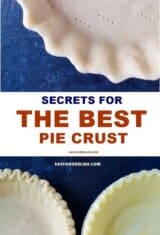
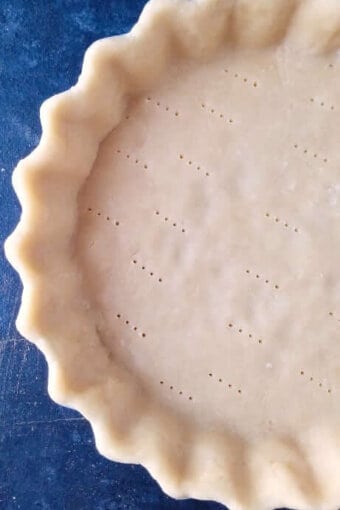
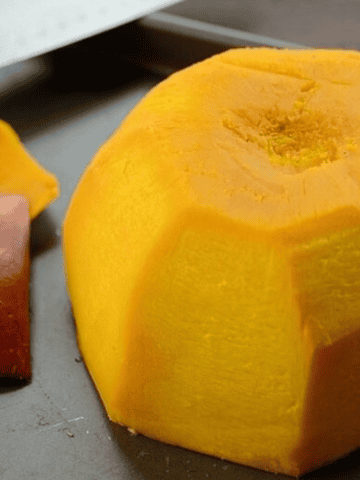
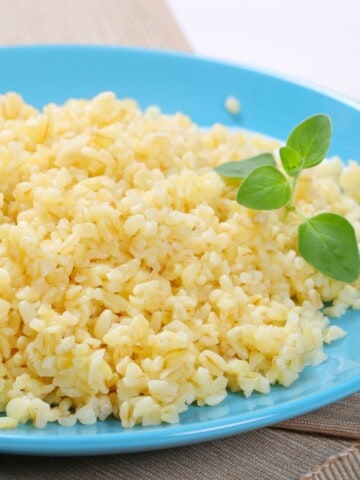
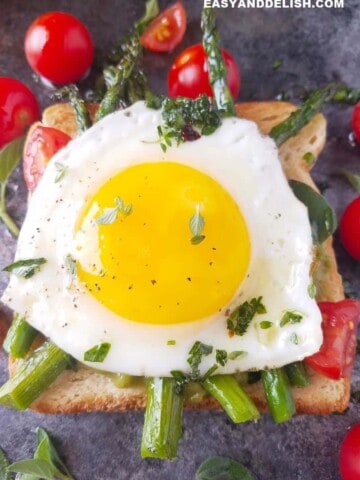
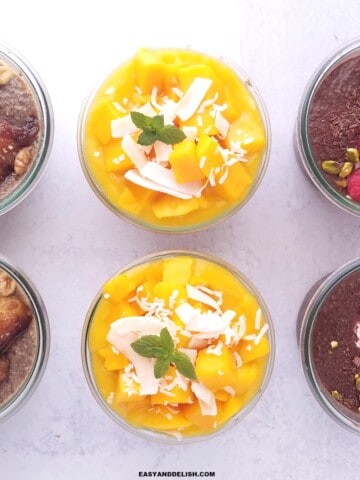
Peggy Rea says
Do I have to use unsalted butter ??
Denise Browning says
No, you don't! However, if you don't want to take the risk your homemade pie crust become too salty, I recommend to use unsalted butter. This is the only way to control the amount of salt especially if you are making a dessert pie.
Miriam says
I have no room for bulky appliances, so how do I make this without a food processor?
Denise Browning says
I see Miriam! No woories! An alternative to a food processor, it is to mix the ingredients and knead the pie crust dough by hand. But make sure to add the ice water and vodka little by little while kneading the dough.
Lenny says
I used your pie crust recipe to make a sweet potato pie. It was perfect, easier to make than I thought.
Mimi says
Well I wasn’t sure I’d see anything different in your recipe. I also use shortening and butter both, maybe because Julia Child always suggested that combination. But vodka?!!!!! Fascinating!!!
mary anderson says
i love the recipe its great how you make it easy for us thanks definitely going to try it out 🙂
Denise Browning says
Thank you Mary! The holidays will be celebrated soon and I really hope this easy recipe and useful tips help you make the best pie crust ever.
John / Kitchen Riffs says
What a great tutorial! Pie crust intimidates a lot of people, but it's pretty easy to make. Although practice certainly helps! Good stuff -- thanks.